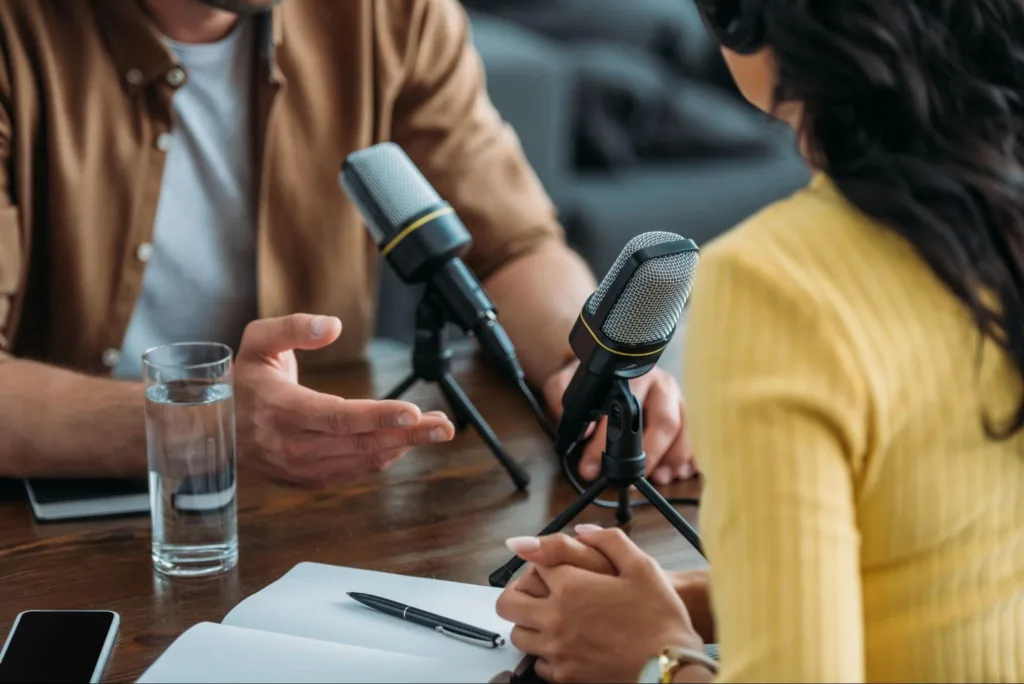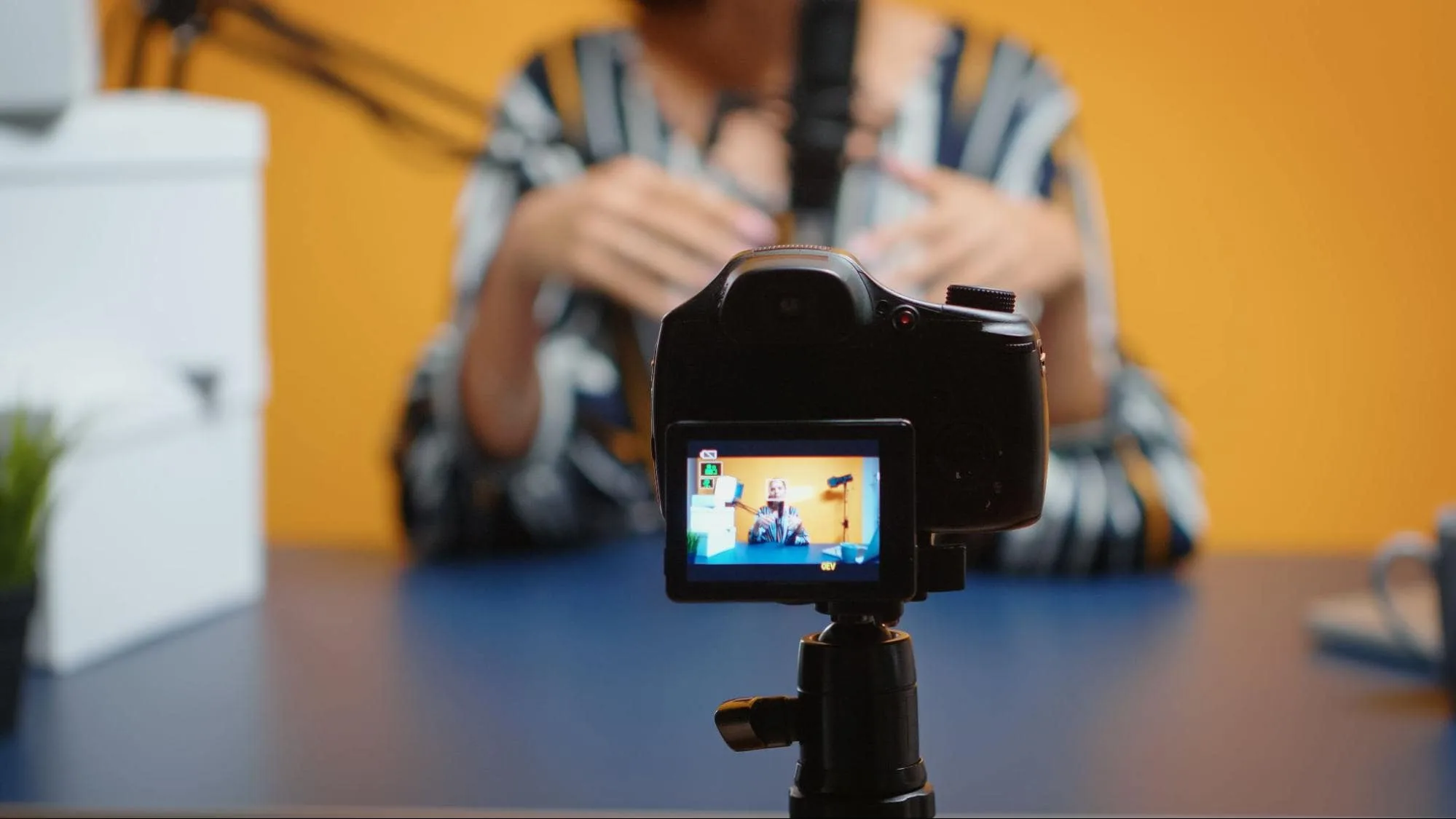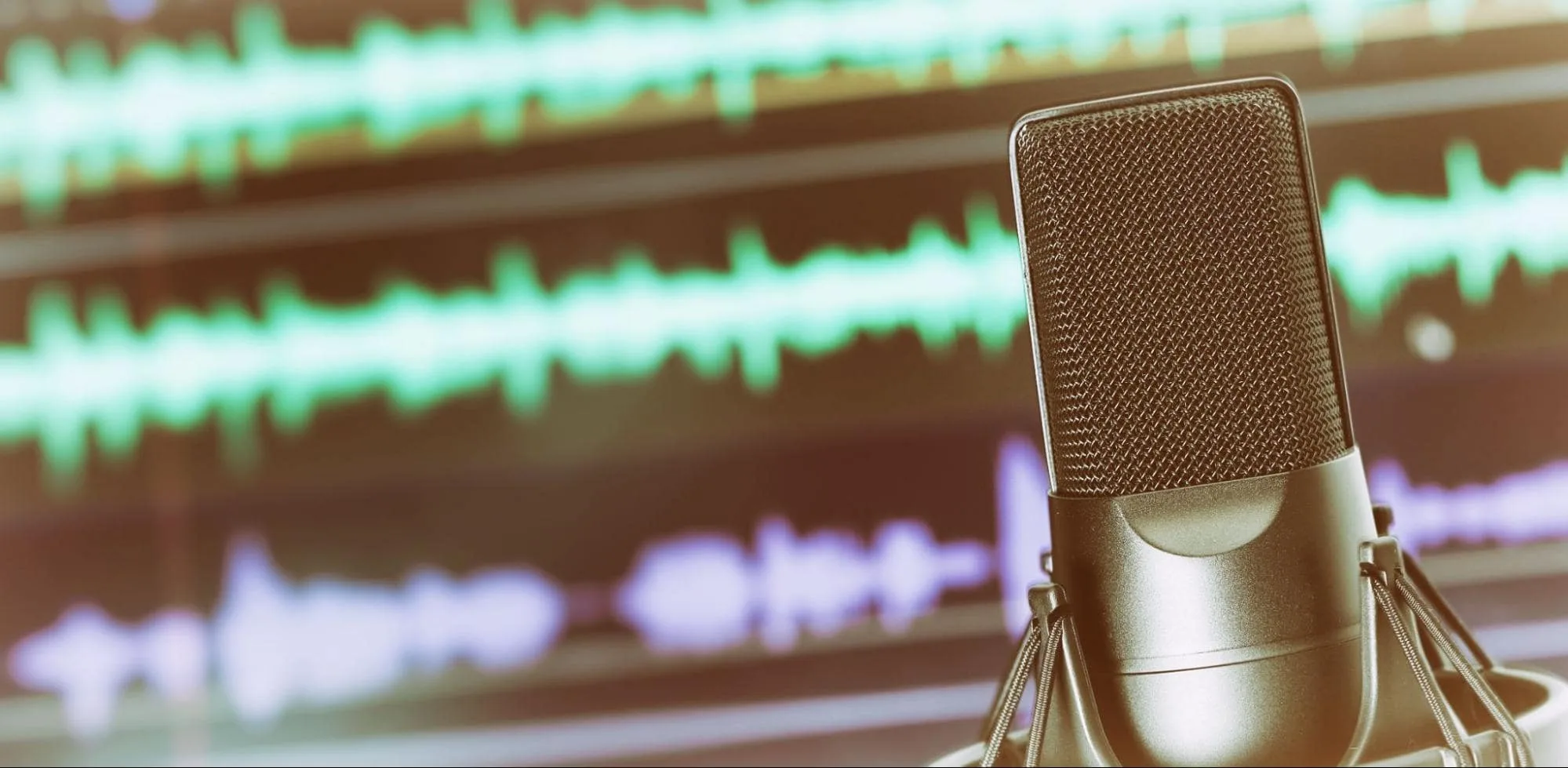The Definitive (And Simple) Guide to Starting a B2B Podcast
- Content Marketing
- Podcasting

Most people were unfamiliar with podcasts before 2005. But we don’t live in that world anymore. With over 383 million podcast listeners globally, it feels like everyone — from actors and comedians to talk show hosts and presidents — has a podcast of their own. While all this signal noise can make you feel like you’re too late to catch the podcasting wave, the data says differently.
In fact, that 383 million is expected to turn into 424 million in the coming year (with projections of continued annual growth). That’s why we’ve created a guide to starting a B2B podcast. We’ll help you understand what you need to get started, how to reach an audience, and how to track your results as you record, distribute, and record some more. Let’s get started.
B2B Podcasting — What Is It?
Before we dive into this guide to starting a B2B podcast, we first need to define the term. A B2B podcast is a podcast created and produced by a B2B (business to business) company. More often than not, it’s started with the intention of boosting brand awareness and building industry authority. It’s also a way to reach potential customers.
Different types of B2B podcasts will focus on different themes and subjects, and use different formats (audio or audio and video). The exact how and what of your podcast will depend on various factors we’ll cover below, including your vision, audience, and goals. However, at the heart of it, a B2B podcast is created with the intention of marketing your company by providing value to your target audience.
Is B2B Podcasting Worth It?
About 40% of all Americans listen to podcasts, a number that’s still on the rise. The audience is certainly there, so if you’re wondering if your podcast will disappear into the ether once you publish your first episode, it won’t (getting listeners is a different story, which we’ll cover below).
The most obvious reason to consider B2B podcasting is that it’s another weapon in the arsenal to help you get your business’s name, product, or service out there. It can help you attract new visitors, customers, and buyers. It can also serve as an excellent addition to your sales process. Additionally, podcasting can also help you network with other leaders in your industry.
Choosing a Team
Before you start thinking about equipment and distribution platforms, you need to think about building a strong team. Remember, your podcast host(s) make up the voice — and possibly, face — of your show. Decide whether you want to do a solo show or more of a roundtable discussion.
There’s no right or wrong decision here, necessarily. However, unless someone on your team has enough of a personality to handle a whole podcast episode themselves, it may be better to start out with a few team members to keep the conversation alive.
If you’re leaning towards a group show, we recommend having no more than 3-4 people on at once. Too many voices on the show can make an episode feel crowded and chaotic.

Getting Started: 3 B2B Podcast Tips
Okay, you’ve assembled the dream ensemble. Now what? Starting a podcast can feel overwhelming, and as B2B podcast production quality continues to improve, it’s natural to feel like there’s a lot to do just to get going. To help you on your way, below are 3 of the most important B2B podcast tips as you start your own podcasting journey.
1. Set Goals
Podcasting is great, but like any marketing initiative, you want to set clear, definable goals so you can make sure it’s worth your time. One way to do this is to use the SMART goals framework:
- Specific. What needs to be accomplished? Who’s responsible for it? What steps need to be taken?
- Measurable. Quantify your goals. Make it easy to track progress and reach the finish line.
- Achievable. Is your objective something you can reasonably accomplish? Goals should be achievable and not too grandiose.
- Relevant. Why are you setting the goals you’re setting? How do they fit into your business’s overall initiatives?
- Time-bound. When will you know the project (i.e., podcast) has been a success? Set realistic goals so you don’t give up after a month but also don’t continue with the same strategy indefinitely if it’s yielding no results.
Also, this is a good time to ask yourself what exactly you want to get out of your podcast. For instance, do you want to:
- Build relationships with your customers?
- Grow your audience for brand awareness purposes?
- Highlight your business’s product or service and drive demand to it?
If your answer is a mix of the above, that’s totally fine. Just be sure to define your goals ahead of time. Also, your goals may change along the way, which is totally normal. The only real failure at the outset of B2B podcast production is failing to set clear expectations and goals for yourself. Doing so could leave you 6 months down the line wondering if what you’re doing is having any effect at all.
2. Find Your Niche & Develop Your Vision
Next up on the list is finding your voice. Unless you want your podcast to speak very generally about your industry with no specific angle, you’ll need to find what makes you worth tuning into. To do this, ask yourself the following questions:
- Who is my audience?
- What is my expertise?
- What value can I offer my audience?
Let’s start with the audience. If possible, reference your company’s buyer personas to help you understand who may tune into your podcast. This will help you craft your voice for the show (serious, light-hearted, somewhere in between) and understand what challenges the audience faces that you can speak to.
Next up, you need to be honest about your expertise. This can include any collective industry knowledge, career history, and anything your business brings to the table that speaks to the needs of your target audience.
This question may also influence our section above on choosing your team. Having the host(s) of your podcast come to the podcasting table with enough industry knowledge and expertise to speak authentically and authoritatively can certainly impact the final product.
However, don’t allow a sense of imposter syndrome to prevent you from getting started. Nothing is perfect, and seldom is any endeavor excellent from the get-go. Sometimes the best way to learn is to five right in.
Finally, understanding the value you bring involves understanding what’s already been done among your industry’s top podcasts. While some overlap is natural, take this time to think of how to create something fresh. You certainly don’t need to reinvent the wheel, but a strict copycat model isn’t the most valuable approach. Instead of “brand-new”, think “brand-better”.
Take some time to listen to the top podcasts in your area of expertise. What are they doing right? Anything they’re doing wrong? From there, incorporate what works and learn to include what the current key players are missing.
3. Get Your Gear
When you’re brand new to starting a B2B podcast, you probably aren’t interested in contracting out and spending money recording at a third-party studio. In fact, one of the benefits of podcasting is the low-overhead it offers. Plus, given the fantastic tools on the market today to create a polished recording sound, you can get stellar sounds for relatively inexpensive.
To make sure you’ve got your tech stack covered before launching your podcast, you’ll want to have the following:
- Equipment. Microphones, headphones, cameras (if you’re doing video), and an audio receiver (if you’re not using USB mics).
- Recording software. For Mac users, Garageband is a free tool that comes with your computer that will suit all of your podcasting needs as your start out. Other popular recording software includes Audacity and Adobe Audition.
- Editing software. This can and will often be the same as your recording software. Using a platform your can record and edit with makes the process even simpler, especially as you’re starting out. Riverside wrote a great blog on some of the top podcast recording software currently on the market!

Launching Your Podcast: 3 More Steps
The next steps in this guide to starting a B2B podcast is to focus on how to actually get your podcast up and listenable for your audience. From hosting to scheduling and style guides, here are 3 more B2B podcast tips to get you from the studio to the internet.
1. Choose Your Hosting & Distributing Platforms
Wondering how to distribute a B2B podcast? It’s actually pretty simple, and there are more than a few platforms available to choose from. Below are five of the most popular podcast hosting platforms:
- BuzzSprout.Often ranked as the best overall hosting platform for podcasts.
- RSS.com. This platform is very affordable and easy to use.
- Podbean. Growing in popularity in recent years, this platform is easy to use. It also supports video.
- Libsyn. At $5 a month, this is one of the most affordable podcast-hosting platforms.
- Soundcloud.This platform offers you the opportunity to upload your podcast directly to Soundcloud and sync your RSS feed with distributing platforms like Apple Podcasts and Spotify.
All of the platforms mentioned above are known as hosting platforms. They allow you to upload your podcast so people can listen to it on the platforms they most frequently use. They’re not, in and of themselves, the platforms your listeners will most likely flock to.
This is where a podcast-distributing platform comes in. We recommend starting out with Apple Podcasts, Spotify, Google Podcasts, and YouTube (if you’re recording video). To get your podcast on a distributing platform, all you need is the RSS feed link generated by your podcast hosting service. From there, just submit the link to each aggregator.
2. Develop a Publishing Schedule
Once the more technical side of getting your podcast started is complete, you want to turn your attention to brainstorming B2B podcast topics and developing a schedule. Popular podcasts will often publish one episode a week. However, it may be better to start out by publishing one episode a month. Just figure out what works best for your schedule and do your best to stick to it.
From a branding perspective, it’s better to start by uploading less frequently but more regularly, instead of recording an episode every week and trailing off after two months. Everything — including the flow of your podcasts, the topics covered, and the production quality — will improve the more you stick with it.
Monday.com offers a great podcast planning template to help you get started!
3. Create a Style Guide
A style guide could include your podcast’s logo, the editing style, and even the set design if you’re doing a video podcast. Whatever it is, we recommend creating a style guide to make sure the podcasts stay consistent.
Something as simple as creating a folder in Google Drive is a good place to start. Have a folder for your podcast’s logo, a Google Doc that describes your podcast’s tone of voice/aesthetic, and anything else that can help other members of your team best represent your brand when they work on the podcast.
Remember, it doesn’t need to be anything too fancy at the start. It’s better to just get started and hone your craft from there, instead of waiting for all the housekeeping items to be in order.

Once you have your first episode uploaded (congratulations, by the way) you should consider how to promote your podcast. Sharing your podcast organically on social media platforms is a good way to get started (especially on LinkedIn). Instagram is another great platform for this, especially if you’re doing a video podcast since you can share smaller clips of each episode on your feed and your account’s story.
Once you have a few episodes recorded and you’re proud of the finished product, you may also consider turning to social media advertising to target a relevant audience. Once again, LinkedIn advertising is a great platform for this, but you may also consider Facebook ads and Google Ads.
Report & Measure the ROI
Any marketing initiative is best when backed by data. Recording your podcast may be fun, but as with any endeavor, you may get to the point where you’re wondering if the input is worth the output. How do you measure your podcast’s success? We recommend tracking ROI with these four frameworks:
- Track your show’s downloads over time.
- Compare your podcast data to your other marketing channels.
- Compare your podcast data to benchmarks of other shows.
- Track any leads/customers that found you through your podcast.
Taking a look at the world’s largest podcasts receiving millions of downloads in a month isn’t going to help you determine whether your podcast is successful or not. The only shows you should focus on are yours and podcasts very similar to yours. From there, simply focus on providing value and building relationships with your ideal customers and clients.
Welcome to the World Of Podcasting
While this guide to starting a B2B podcast has all the things you need to get started, it isn’t intended to be the be-all and end-all of your podcasting journey. Take the B2B podcast tips we’ve shared in this blog and apply them to your project. You’ll most likely experience some roadblocks along the way — and that’s okay. Just keep working at it and refining your strategy as you go. Happy ‘casting!
Join Team Tower over at After Hours to learn more about promoting your brand and elevating your business through content, social media, and PPC.
 Grace H
Grace H